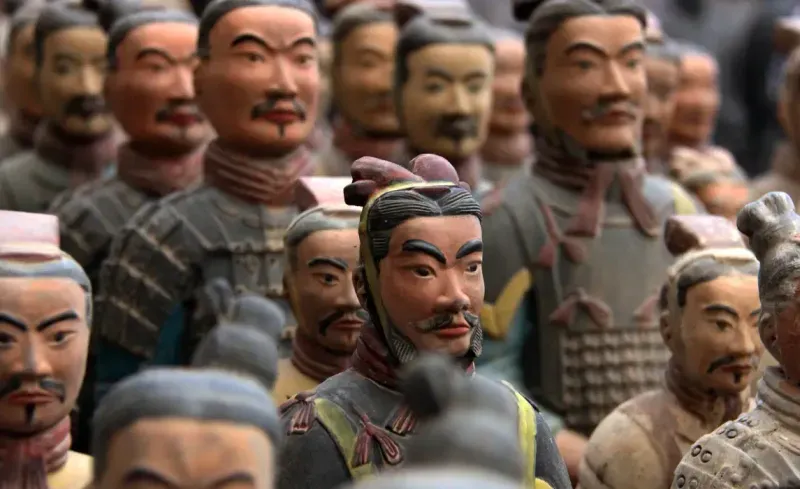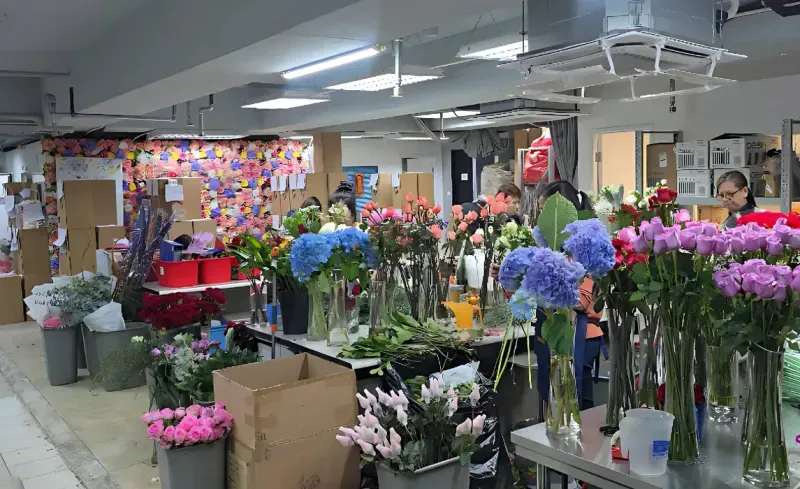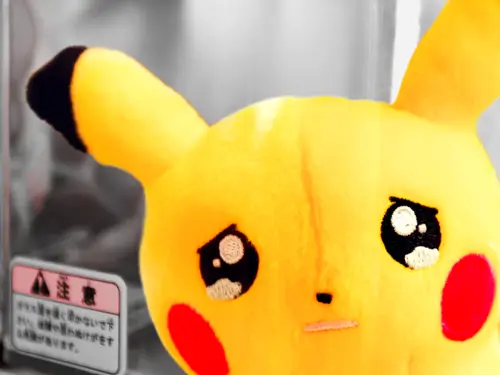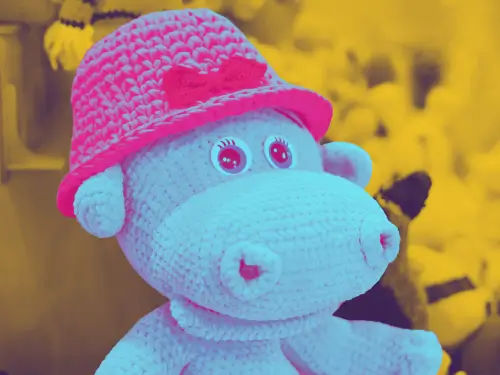Shanghai’s shopping scene is a tale of two worlds — the glittering luxury malls of Pudong and the bustling street markets where locals find real bargains. Whether you’re after a custom-tailored suit, trendy streetwear, or unique boutique pieces, the city delivers it all. From designer labels to hidden gem workshops, here’s your essential guide to exploring Shanghai’s diverse clothing stores and discovering where style truly meets culture.
1. IFC Mall: Where Luxury Meets the Shanghai Skyline
📍 Location: Century Avenue, Lujiazui, Pudong
Metro: Lujiazui Station (Line 2), Exit 7
Hours: 10:00 AM - 10:00 PM daily
Budget: High-end (coffee ¥45-80, meals ¥200-400+)
Why IFC Mall Stands Apart
Opened in 2010 at the base of one of Asia's tallest skyscrapers, IFC Mall combines architectural drama with practical luxury shopping. The soaring atrium with polished marble floors feels more like a contemporary art museum than a shopping center.
What genuinely sets IFC apart? It's the only luxury mall in Shanghai where you can buy a Chanel bag and your groceries in one trip. While ground floors showcase Gucci and Louis Vuitton, the lower level houses City'Super—an upscale supermarket selling Japanese wagyu, imported French cheeses, and organic produce. The cylindrical glass Apple Store has become an Instagram landmark with its spiral staircase and minimalist design.
What You'll Actually Spend
Luxury goods match international pricing—a Louis Vuitton Neverfull costs roughly ¥10,500 ($1,450 USD), within 5-10% of US prices. There's no tax advantage for tourists anymore. Where IFC becomes accessible: coffee runs ¥45-80 ($6-11 USD), casual lunch costs ¥80-150 ($11-21 USD) per person, and upscale dinner with Bund views is ¥200-400 ($28-55 USD) per person. City'Super groceries for two cost ¥100-200 ($14-28 USD).
The Real Reason to Visit
Even if you're not shopping luxury brands, the upper-floor restaurant terrace offers spectacular Bund views without paying observation deck prices. The marble-floored atrium is perfect for people-watching—you'll see Chinese influencers staging photo shoots, elderly shoppers browsing jewelry, and business people conducting impromptu meetings over coffee.
Insider timing: Visit weekday mornings (10-11 AM) before tour groups arrive. Weekend afternoons become chaotic with crowds and wait lists at every café.
Read Related Article: Best Souvenirs and things to buy in China
Discover the best souvenirs and things to buy in China—from traditional teas and silk scarves to jade jewelry, calligraphy sets, and handcrafted ceramics. Explore unique keepsakes that capture China’s rich culture and craftsmanship, perfect for gifts or personal mementos.
Read More
2. AP Plaza: Shanghai's Real Electronics and Bargain Market
📍 Location: Century Avenue, near Science & Technology Museum, Pudong
Metro: Science & Technology Museum Station (Line 2)—exit directly into the building
Hours: 9:00 AM - 6:00 PM daily
Budget: Low to moderate (bargaining essential)
What Makes AP Plaza Different
AP Plaza isn't primarily a tourist market—it's where Shanghai residents get iPhone screens replaced, buy phone accessories in bulk, or find affordable clothing. You'll see actual Chinese families shopping here, which brings real benefits: more reasonable prices, reliable repair quality, and less aggressive bargaining.
The electronics repair shops on lower levels are trusted by Shanghai's expat community. Expect ¥200-400 ($28-55 USD) for same-day iPhone screen replacement with 30-90 day warranties. These are legitimate small businesses with years of operation, not sketchy pop-up stalls.
The Bargaining Game: Actual Numbers
Vendors open with absurd quotes—sometimes 500% above realistic prices. Here's what actually happens: Designer handbag replica starts at ¥1,200 → settles at ¥200-300 ($28-42 USD). Branded t-shirt opens at ¥500 → closes at ¥80-120 ($11-17 USD). Sunglasses start at ¥300 → end at ¥50-80 ($7-11 USD). Phone cases open at ¥80 → settle at ¥15-25 ($2-3.50 USD).
The strategy: Start at 20-25% of their first quote, smile, stay friendly, and walk away slowly if needed. About 60% of the time, they'll call you back with better offers.
What Works Well Here
Phone accessories (charging cables ¥10-30, cases ¥15-35, screen protectors ¥20-40) cost a fraction of retail. Clothing quality varies wildly—check stitching, zippers, and fabric weight carefully. The upper level food court charges ¥25-50 ($3.50-7 USD) per meal.
Pro tips: Bring cash (many vendors don't take cards), visit mornings when staff are fresher, and manage expectations—everything here is a copy or grey-market product. Judge items on their actual value, not fake authenticity claims.
3. South Bund Fabric Market: Where Tailoring Magic Happens
📍 Location: South Bund area (taxi ¥30-50 from city center)
Metro: South Huangpi Road Station + 10-minute walk
Hours: 9:00 AM - 6:00 PM (some stalls closed Sundays)
Budget: Moderate to high-end custom work
Why This Market Has International Fame
This is Shanghai's tailoring heartland where diplomats, expats, and savvy travelers get custom suits, dresses, and qipaos made. NBA players like Dirk Nowitzki have had suits made here. These aren't street tailors—they're established businesses with extensive fabric libraries, international pattern books, and decades of expertise.
The Custom Tailoring Process
Day 1 (2-3 hours): Browse fabric swatches, discuss design details (collar style, buttons, pockets), get 15-20 measurements taken. Bring Pinterest screenshots of styles you like. Pay 30-50% deposit.
Day 3-4 (30-45 minutes): First fitting with preliminary version. Tailor marks 5-20 adjustments with chalk while you're wearing the garment.
Day 5-6: Final pickup. Reputable tailors adjust until you're 100% satisfied. International shipping available for ¥200-400 ($28-55 USD).
Real Pricing Breakdown
Custom Suits: Good quality fabric ¥2,000-3,000 ($280-415 USD), premium imported fabric ¥3,500-5,000 ($485-690 USD), ultra-luxury ¥6,000+ ($830+ USD). Compare to $800-2,500 in US/Europe.
Dresses/Qipaos: Simple designs ¥800-1,200 ($110-165 USD), complex silk designs ¥1,500-2,500 ($210-345 USD), beaded/embroidered ¥2,000-4,000 ($280-550 USD).
Shirts: ¥300-600 ($42-83 USD) each. Order 3-4 for 10-15% discount.
Vendor Recommendations
Joyce & Rita, Stall 129: Impeccable men's suits, patient and detail-oriented, excellent English.
Stall 159: Women's formal wear and qipaos, skilled at modernizing traditional designs.
Suits by Susan, Stall 167: Ground floor, perfect English, handles rush orders (48 hours possible), works with international clients.
Critical timing: Visit Day 2-3 of your Shanghai trip. You need 4-5 days minimum for the complete process. Budget 2-3 hours for first visit—it's a consultation, not quick shopping.
Read Related Article: Spark Your Business: Top Wholesale Jewelry Suppliers in China
Spark your business with the top wholesale jewelry suppliers in China. Explore trusted manufacturers offering high-quality pieces, competitive pricing, and global shipping for retailers and boutique owners looking to elevate their jewelry collections.
Read More
4. Shanghai Fashion Store: The Tourist Trap to Avoid
📍 Location: 580 East Nanjing Road
Metro: East Nanjing Road Station (Lines 2, 10)
Hours: 10:00 AM - 9:00 PM daily
Recommendation: Skip it or photo-only stop
The Uncomfortable Truth
This European-style building looks charming but operates with aggressive scam tactics. The "store" is dozens of commission-based vendor stalls using high-pressure sales techniques that frequently trap tourists.
What Actually Happens
Vendors ask seemingly innocent questions ("Where are you from?") to assess your wealth. Items mysteriously appear in shopping bags without your approval. You're pressured toward checkout. Receipts list everything generically as "women's shirt" with identical stock numbers, making disputes impossible. Later, you discover you were charged for items you explicitly declined. No refunds or exchanges exist.
If You Must Go
Don't answer personal questions. Keep hands on your bags constantly. Photograph every item before it goes in the bag. Count items before and after payment. Expect ¥50-200 per item ($7-28 USD) after bargaining—and accept you're still overpaying 200-400% compared to other markets.
Better Alternatives
Everything here is available at AP Plaza for less money without pressure tactics. Or visit modern malls like Raffles City for legitimate retail shopping. The building makes a decent exterior photo—that's the only reason to stop by. Local Chinese people and expats avoid this place entirely.
5. Qipu Road Market: The Wholesale Clothing Maze
📍 Location: Qipu Road, Northern Shanghai
Metro: Tianmu Road Station (Line 10)
Hours: 8:00 AM - 7:00 PM daily
Budget: Ultra-low (wholesale pricing)
Warning: No AC in summer—brutally hot
What This Market Actually Is
Qipu Road is where Taobao sellers source inventory. Three massive buildings with thousands of tiny stalls across five floors. You'll see vendors photographing items for online listings and packing bulk orders. This serves Chinese e-commerce first, walk-in customers second—the most authentic, least tourist-friendly destination on this list.
The No-Frills Reality
No fitting rooms (wear form-fitting clothes to check sizes). Limited bargaining (prices already wholesale). Cash strongly preferred (WeChat Pay/Alipay need Chinese accounts). No English spoken (bring translation app). No AC in summer (temperatures reach 35°C/95°F). Overwhelming (thousands of similar stalls cause decision fatigue).
What You'll Pay (Wholesale Prices)
T-shirts ¥15-40 ($2-6 USD), jeans ¥50-120 ($7-17 USD), dresses ¥40-150 ($6-21 USD), sneakers ¥80-200 ($11-28 USD), sweaters ¥60-150 ($8-21 USD), accessories ¥10-50 ($1.50-7 USD). For perspective: ¥500 ($70 USD) buys 3-4 jeans, 5-6 shirts, and accessories. A ¥1,000 trip ($140 USD) restocks an entire wardrobe.
Floor Breakdown
Floors 1-3: Mass-market, extremely crowded, rock-bottom prices but most chaos. Vendors focused on online orders, mixed quality.
Floor 4: Better quality, slightly higher prices (20-40% more), calmer atmosphere. If you only visit one floor, choose this one.
Floor 5: Men's clothing focus, more spacious, fewer options.
Shopping Strategy
Come with a specific list (prevents decision fatigue). Shop decisively without fitting rooms—know your measurements in centimeters. Visit weekday mornings (9-11 AM) before crowds peak. Bring large bag, water, translation app, and patience. Check stitching, zippers, and fabric weight on every item (spend 30 seconds per piece).
Bargaining is limited here. Ask "Best price?" when buying multiple items—might get ¥10-20 off. Buying 5+ pieces gets 10-15% off total.
Why Locals Shop Here
A t-shirt retailing for ¥150 at malls costs ¥25 here. Chinese families buy school clothes, work attire, and basics because the savings are dramatic. Quality is adequate for most purposes. This isn't pleasant air-conditioned shopping—it's raw wholesale commerce. Some find it exhilarating, others exhausting. Know your chaos tolerance before committing hours.
Read Related Article: Best Hong Kong Flower Shop | Flower Delivery & Gifts
Find the best flower shops in Hong Kong offering beautiful bouquets, same-day flower delivery, and thoughtful gift options. Perfect for birthdays, anniversaries, and special occasions—bring joy to your loved ones with fresh, elegant floral arrangements.
Read More
Choosing Your Shanghai Shopping Adventure
Shanghai offers a shopping experience like no other, blending luxury, craftsmanship, and chaos in the best possible ways. Head to IFC Mall if you prefer air-conditioned elegance, sleek architecture, and top-quality brands—set aside around ¥200–500 ($28–69 USD) for coffee and meals. Visit AP Plaza if you need quick phone repairs or enjoy the thrill of bargaining for knock-offs; plan two to three hours here with a similar budget. For those seeking bespoke style, the South Bund Fabric Market is essential—schedule a visit early in your trip for measurements, fittings, and custom pieces, budgeting ¥2,000–5,000 ($280–690 USD). Skip Shanghai Fashion Store unless you’re after a few exterior photos, as most items inside can be found elsewhere for less. If you’re comfortable navigating heat and crowds, Qipu Road offers unbeatable wholesale clothing prices—expect to spend ¥300–1,000 ($42–140 USD).
Suggested Itinerary
Day 1: Fabric Market morning (consultation/measurements). IFC Mall afternoon (coffee/architecture).
Day 2: AP Plaza morning (bargaining practice). Fabric Market afternoon (first fitting).
Day 3: Explore Shanghai. Fabric Market for final pickup.
Day 4 (optional): Qipu Road morning for wholesale hunting.
This schedule provides variety, manages energy levels, and ensures proper timing for custom tailoring. You'll experience the full spectrum—from polished luxury to gritty authenticity. In Shanghai, the shopping experience is often more memorable than what you actually buy.
FAQs
Discover the best places to shop in Shanghai—from the polished luxury of IFC Mall to the energetic stalls of Qipu Road. This guide breaks down where to go, what to expect, and how to plan the perfect shopping itinerary, whether you’re after designer labels, local crafts, or custom-made fashion.
1. What’s the best way to pay when shopping in Shanghai?
While many high-end malls accept international credit cards, most local markets and smaller shops prefer mobile payments like Alipay or WeChat Pay. Carry some cash (RMB) for convenience, especially in places like Qipu Road or the Fabric Market, where card payments may not be available.
2. Can tourists get tax refunds on shopping in Shanghai?
Yes. Tourists can receive a 11% VAT refund on purchases from designated tax-free stores when spending at least ¥500 (about $70 USD) in one day at the same shop. Be sure to bring your passport and keep your receipts to claim your refund at the airport before departure.
3. When is the best time of year to shop in Shanghai?
The best times to shop are during end-of-season sales—typically January–February and July–August—when major discounts hit luxury malls and local boutiques alike. Visiting during spring or autumn also offers comfortable weather for exploring outdoor markets and shopping streets.


.webp)
.webp)
.webp)
.webp)
%2520(1).webp)
.webp)
.webp)
.webp)
.webp)
.webp)
.webp)
.webp)
.webp)
.webp)
.webp)
.webp)
.webp)
.webp)
.webp)
.webp)
.webp)
.webp)
.webp)
.webp)
.webp)
.webp)
.webp)
.webp)
.webp)
.webp)
.webp)

-p-800.webp)

.webp)

